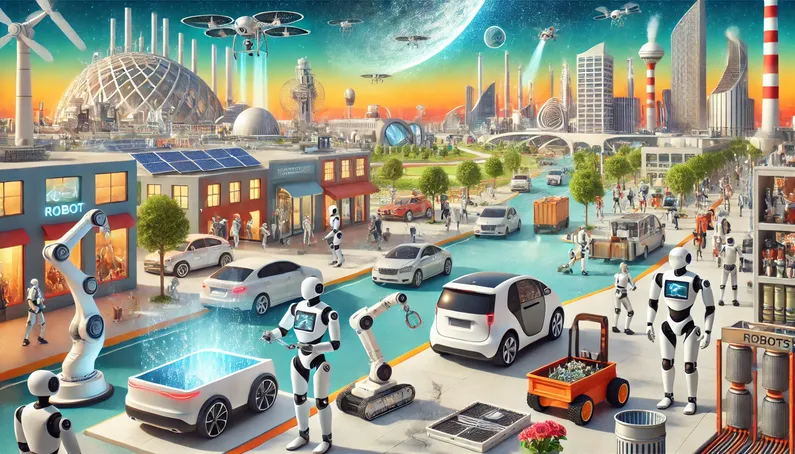The Future of Robotics - Opportunities and Risks

Introduction
Robotics has grown from a concept of pure imagination into an essential component of modern life. Today, robots are not only intelligent and autonomous but also incredibly versatile. They perform tasks ranging from making coffee to executing precise surgeries—achievements that were once considered the domain of science fiction. Picture this: a robot assistant not only parks your car but also cleans your home while suggesting your next audiobook based on your preferences.
In this article, we explore the opportunities robotics presents and the challenges it introduces, reshaping industries and societies alike.
Historical Context
Human fascination with mechanical helpers dates back thousands of years. Ancient civilizations, such as the Greeks, experimented with automata—early mechanical devices designed to mimic life. Heron of Alexandria’s famous steam-powered bird could flap its wings and chirp, showcasing the ingenuity of its creators. These inventions were primitive, yet they symbolized humanity’s persistent desire to create machines that could ease their workload.
A major leap in robotics came in 1956 when George Devol and Joseph Engelberger introduced “Unimate,” the first industrial robot. Designed to automate repetitive and hazardous tasks, Unimate revolutionized factory work at General Motors. It could weld, lift, and transport materials with efficiency unmatched by human workers. This marked the beginning of robotics as a transformative force in industries, paving the way for the automated systems we see today.
Modern Applications of Robotics
Robotics has permeated nearly every sector, improving efficiency and opening new possibilities:
Manufacturing
Factories have become centers of robotic innovation, with robots performing tasks like welding, painting, and quality control. Tesla’s advanced robotic systems exemplify this evolution, as they handle intricate production processes with speed and precision. Collaborative robots, or “cobots,” are also gaining traction. These machines work alongside humans, enhancing safety and boosting productivity without replacing human oversight.
Healthcare
In medicine, robotics has redefined surgical precision. The Da Vinci surgical system allows doctors to perform minimally invasive procedures with unparalleled accuracy, reducing recovery times for patients. Beyond surgery, robots are playing key roles in rehabilitation, helping individuals regain mobility through personalized therapy programs. Additionally, robotic devices are being developed to assist with patient care in hospitals, addressing the growing demand for efficient healthcare solutions.
Logistics and Retail
The logistics sector has embraced robotics to streamline operations. Robots in warehouses sort, pack, and transport goods with remarkable efficiency. Amazon Robotics, for instance, has accelerated delivery times while reducing errors. In retail, robots are increasingly being used for inventory management, shelf stocking, and even direct customer interaction, providing tailored shopping experiences.
Domestic Assistance
Robots have become indispensable in homes, where they handle routine chores and improve quality of life. Devices like Roomba autonomously clean floors, while advanced systems assist with meal preparation or caregiving for elderly individuals. Such innovations are transforming the way households function, saving time and effort for millions.
Exploration and Research
Robots venture into environments that are inaccessible or dangerous for humans. NASA’s Perseverance and Curiosity rovers, for example, continue to uncover valuable data about Mars, contributing to humanity’s understanding of the planet’s history and potential for life. Similarly, underwater robots explore ocean depths, aiding scientific discovery and advancing climate research.
Opportunities and Challenges in Robotics
Expanding Potential
As robotics technology advances, its applications continue to grow:
- Smart Cities: Robots are expected to manage urban infrastructure, optimizing traffic flow, maintaining public spaces, and improving waste management. Autonomous vehicles, for instance, promise to make daily commutes safer and more efficient.
- Personalized Healthcare: Robotic systems could revolutionize patient care by providing tailored treatments and real-time health monitoring, potentially detecting and addressing medical issues before they become severe.
- Space Exploration: Robots are poised to lead humanity’s push into space, constructing lunar and Martian habitats and mining asteroids for resources vital to future technologies.
Pressing Challenges
However, the rapid growth of robotics also introduces significant concerns:
- Job Displacement: Automation is replacing human workers in industries like manufacturing, retail, and customer service. For instance, self-checkout kiosks are reducing the need for cashiers. Retraining programs are essential to help displaced workers transition to new roles.
- Ethical Questions: As robots gain autonomy, determining accountability becomes complex. Who is responsible if a self-driving car causes an accident? How do we ensure robots respect privacy and human rights?
- Cybersecurity Risks: Connected robotic systems are vulnerable to hacking. A breach in a medical robot or autonomous vehicle could have catastrophic consequences, underscoring the need for robust security measures.
- Global Inequality: The adoption of robotics is uneven, with wealthier nations benefiting disproportionately. Developing countries may struggle to access these technologies, exacerbating existing disparities.
Economic and Social Impacts of Robotics
The rise of robotics is transforming economies and societies in profound ways:
- Increased Productivity: Robots work tirelessly, boosting output and reducing costs for businesses. This efficiency makes goods more affordable for consumers.
- New Career Opportunities: While automation displaces some jobs, it also creates demand for roles in programming, robotics engineering, and system maintenance. Educational institutions must adapt to prepare workers for these emerging fields.
- Redefining Human Roles: By taking over repetitive or hazardous tasks, robots allow humans to focus on creativity, innovation, and strategic decision-making.
Future Outlook
The future of robotics holds immense promise. As technology becomes more advanced, robots will increasingly integrate into everyday life, from managing smart cities to assisting individuals in their homes. However, this integration must be accompanied by thoughtful policies, ethical guidelines, and equitable access to ensure that the benefits of robotics are shared widely.
By addressing the challenges proactively, humanity can create a harmonious coexistence with machines, leveraging their capabilities to build a more sustainable and prosperous future.
Image Disclaimer
This illustration was created using the DALL·E (OpenAI) tool and is included solely for illustrative purposes under OpenAI’s usage terms. Any further use, alteration, or distribution of this image by the purchaser (or third parties) is at their own discretion and responsibility. Please consult OpenAI’s terms for more information.